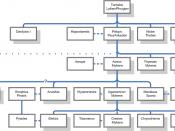The first scene opened with Artemis. She explained who she was, and why she was looking for a sacrifice from Agamemnon. This set the ball rolling for the rest of the play. It was interesting how key female members of the tale, Helen, and Iphegenia, avoided certain death, which left them available to be tied in, with the rest of the plot. What seemed like a pretty stiff punishment to Agamemnon for shooting a deer and boasting about it was actually even harsher in reality. I was never really quite clear, as to if Artemis knew in advance what the outcome of the believed sacrifice would be. The actress who portrayed Artemis, appeared through her reaction to the ensuing plight of Elektra, to be truly saddened. It wasn't until the tale of Elektra that we learned from Aigisthus how the curse had been placed upon Atreus children. From an Ethics standpoint, it would lead you to believe that the Greeks believed in Hard Determinism, as a moral code.
It wasn't until the last act of Iphegenia, that the lesson seemed to shift to a Soft Deterministic point of view, showing the characters could have changed their fate. The whole series of tragic events were set into place by an Egotistical act of boasting, and made worse by women of questionable moral fiber. When all the events are reviewed (Tantalus eating his children notwithstanding) the simple influence of humility, and fidelity would have avoided all the death and suffering that followed. If I were going to pick a message from the story, it would be that the suffering and injustices from the past cannot be resolved, by suffering and injustice in the present. Humility and the act of forgiveness alone will allow the wounds of past transgressions to...


